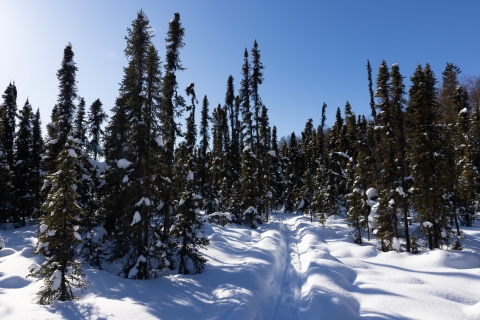As winter settles in across Alaska, the landscape shifts from vibrant reds and golds of autumn to a more subtle light: pastel pinks of a sun low on the horizon and moonlit blue on the snow. Wildlife and people adjust to the change and prepare to move through the longer nights with different activities. This can be a time of story, travel, and celebrations, and also of challenge, endurance, and adaptation.
Alaska’s national wildlife refuges are the traditional homelands of many Indigenous peoples, stewards of these lands, waters, and wildlife since time immemorial. Alaska Native languages connect in deep and meaningful ways with the local environment, expanding our understanding of these wild places in their seasonal cycles.
At this changing edge of winter, we share just a few words and phrases from different language groups located on Alaska refuges. We honor the traditions, cultures, and languages that deepen connections with these places, and celebrate the turning points, fellowship, and beauty of the season!
Koyukuk Refuge — Koyukon Athabascan
“Edzoo hoolaanh!’ we exclaim; “it’s cold!” This is the time of year when we haven’t adjusted to the winter weather, yet we welcome it. Ice on lakes and rivers thickens in the cold, making winter travel safer for humans and wildlife. Snow fills the hollows between sedge tussocks, opening up winter overland trails and providing an insulative blanket that protects marten, voles, shrews and grouse.
In Denaakk’e (Koyukon Athabascan) this is “ts’eyeets’en hʉgh kk’aatl’ot”, the first half of winter. Literally this means the time “from the canoe to solstice” — between the freeze-up of waterways and the shortest day of the year. It is a time of change, but also wondrous beauty as the landscape takes on the muted colors of winter.
Izembek and Alaska Maritime Refuges — Unangax̂
Unangam Tunuu is the language of the Unangax̂ people, whose traditional lands include the southwestern area of the Alaska Peninsula, the Pribilof Islands, and the Aleutian Archipelago.
Chngatux̂, the Unangax̂ word for sea otter (singular), live in the cold marine waters around many areas of coastal Alaska, including the nearshore of Alaska Maritime and Izembek refuges.
The Native Village of Atka in the Aleutian Islands contributed this fun and fascinating language fact: chngatux̂ comes from the root word ‘chngax̂’ meaning ‘fur’ and the suffix -tux̂, indicating an abundance. So chngatux̂ translated literally into English would be close to “furry one.”
Sea otters lack the blubber that keep most marine mammals warm in the frigid North Pacific Ocean. Instead, they have incredibly dense fur that traps air and insulates their body like a puffy jacket.
Kodiak Refuge — Alutiiq Sugpiaq
In English and western cultures, we ask someone: “how old are you?” In Alutiiq Sugpiaq, there is no word for year so the question is a little different: Qaugcinek uksungq’ rcit, or “how many winters do you have?”
In the Alutiiq Sugpiaq culture, winter is a time for social activities and celebrations. Families spend most of the year away at a fish camp or hunting. In the Winter months, many returns to a central village to visit, celebrate, and share the fish, berries, and game harvested over the past year.
Kanuti Refuge — Koyukon Athabascan
“Dʉhtseedle’, dʉhtseetl” means “snow on trees” in Koyukon Athabascan, and specifically, the kind of snow that provides moisture, which can aid survival out on the land. As snow returns to Kanuti Refuge and Interior Alaska, it’s that time of year again…to start enjoying the outdoors in winter!
Selawik Refuge — Iñupiaq
In both the Coastal/Kotzebue Sound and upper Kobuk dialects of the Iñupiaq language, November is known as “Nippivik,” or sunset time. This is the month during which daylight declines rapidly and winter truly sets in. Although days grow short in this region which straddles the Arctic Circle, pastel sunset hues reflecting off the snow and ice provide enough illumination for ice fishing and other seasonal outdoor activities to continue.
Arctic Refuge — Gwich’in
November is the Month of the Sheep — Divii Zhrii. In the early days, the hunters make preparation to travel to Nitsii Ddhaa (the Big Mountain) near Red Sheep Creek to hunt Dall sheep. They travel with a boat and then hike Nitsii Ddhaa. When hunters harvest a sheep, they butcher and clean it, and then bring it back to the village to share with everybody.
There are many sheep stories told throughout the generations: Dall sheep are considered very sacred, and the stomach and guts are a delicacy for the elders.
Tetlin Refuge — Upper Tanana
In the Upper Tanana Athabascan language, the word for this month is Debee saa. This is the sheep rut moon with a bright moon shining above the Mentasta and Nutzotin mountains and down upon the Upper Tanana. The time of year when the moon shines bright on clear winter nights… the type of night where you can navigate with the illumination of the moon.
Yukon Delta Refuge — Yup’ik
“Uivik” is a Yup’ik word for the month of December. Meaning the turning point, or literally said, “a place to turn.” Uivik for the month of December means the longest nights of the winter season are nearing the turning point with promises of gradual lengthening of days as the season begins to change with the coming of spring.
Alaska Maritime Refuge — Tlingit
Alaska Maritime refuge spans thousands of islands across the state, including St. Lazaria Island near Sitka in SE Alaska, an important nesting place for almost half a million seabirds.
Bob Sam, a Tlingit storyteller and culture bearer from Sitka, shares: “Keet Gushi Heen refers toa killer whale fin going through water.” The fin creates waves that wash ashore, and the waves are considered a supernatural event that bring good luck.
Kenai Refuge — Dena’ina
Daggeyi means friendly or with good cheer, pronounced da-guy-yee, in the Outer Inlet dialect of the Dena’ina language.
Daggeyi also represents fellowship, one of the traditional cultural values of the Kenaitze Tribe, Kahtnuht’ana Dena’ina, who have lived on the Kenai Peninsula for thousands of years.
…
Explore this story map for more about Alaska’s refuges and Indigenous homelands and language groups: Homelands and Public Lands
Contributions from: Amy Peterson, Dehrich Schmidt-Chya, Joanne Bryant, Travis David, Christopher Tulik, Bob Sam, Kenaitze Youth Interns, Atka Tribal Council, Karin Bodony, Kristin Reakoff, and Brittany Sweeney. Layout and compilation by Erin Strand and Lisa Hupp.













